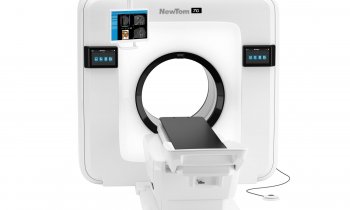Updating opinions on radiation dose levels
Under constant and continuing debate, and given the increasing use of CT and interventional imaging, the issue of radiation dose management was the focus of an ECR session with Dr Manthos Koutalonis, Medical Physicist at the Barts and The London NHS Trust – Radiation Safety Group, as moderator and presentations by three key speakers.

‘The session,’ explained medical physicist Dr Manthos Koutalonis, ‘will outline the importance of dose management in a hospital and the application of dose reduction techniques.’ It will cover the critical issues of when a dose-related examination is performed, from justification to ensuring that dose is kept As Low As Reasonably Achievable (ALARA), whilst balancing this with image quality. The impact of new imaging technology on patient dose reduction also will be highlighted.
Managing dose is probably the most important task for a clinical radiation safety team, Dr Koutalonis emphasised. ‘It primarily raises the need to guarantee a clear justification to undertake an examination involving ionising radiation, based on an assessment of the benefit/risk balance of the examination. This is a complex task and can only be achieved with full cooperation between medical staff and radiation experts.’
When setting a dose, the individual patient’s sex, age, body size and the number of high-dose imaging procedures planned are key considerations. How low or high a dose can go are primarily dictated by the examination needs regarding image quality.
‘The final amount of dose given to the patient is a combination of several factors such as technology, techniques applied, as well as staff training and experience.’
However, procedures known to result in higher radiation dose values, such as those involving CT and interventional imaging, are drawing particular attention today as their frequency is increasing and they lead the contributors to medical exposure.
There are clear benefits to interventional radiologists from dose management/reduction, as it reduces the risks of them developing acute and long term radiation injuries, explained Dr Koutalonis. ‘For the patient, internationally accepted dose-risk models indicate that dose reduction results in direct radiation risk reduction concerning stochastic effects and therefore an expected benefit for the patient.’
Radiologists involved in reporting should be willing to cooperate in the establishment/review of acceptable levels of image quality, adjusted to state of the art technology. Dose reduction can have implications if not managed correctly.
Recently, deterministic acute radiation injuries associated to diagnostic imaging procedures have been publicly reported, highlighting the need of carefully managing dose.
But he also warned that, if dose reduction is excessive and leads to poor diagnostic image quality, it may result in the need to repeat the examination, leading to higher doses in total.
At present, dose reduction has mainly focused on ‘high dose procedures’ and ‘increased risk procedures’ typically associated with CT and interventional examinations, but improved contrast agents and technology are factors in helping reduce the dose.
‘Doses on all x-ray examinations are reduced continuously in the last years,’ Dr Koutalonis said, ‘something which shows that we can expect even lower doses for the future.’
The session, co-moderated by Dr J N Vassileva (Sofia), will also include talks by: Dr Jan Persliden (Department of Medical Physics, Örebro University Hospital, Sweden) on the comparison between digital and conventional radiography; Professor Willi A Kalender (Institute of Medical Physics, University Erlangen-Nürnberg) addressing CT dose reduction techniques, and Dr John R Mayo (Radiology Department, University of British Columbia, Vancouver), who will discuss justification in clinical practice.
‘This session can offer radiologists an updated overview on dose management and associated challenges in clinical routine,’ said Dr Koutalonis. However, stressed that the session will also benefit medical physicists and radiographers, because dose management is a ‘matter of teamwork.’
07.03.2010










